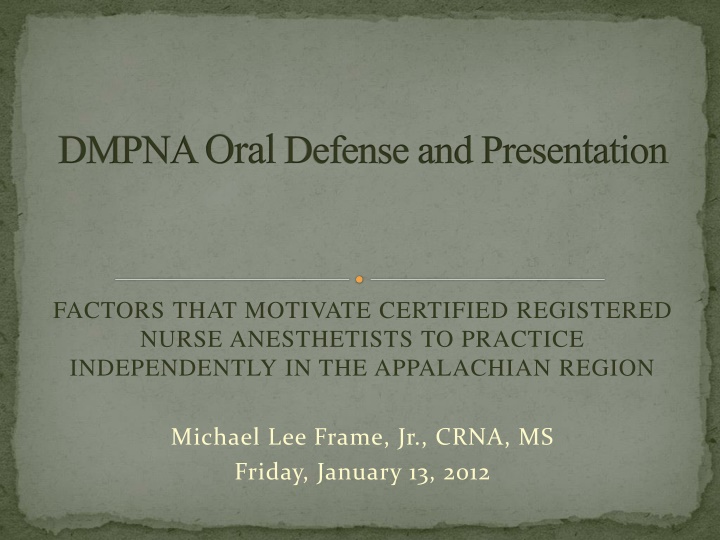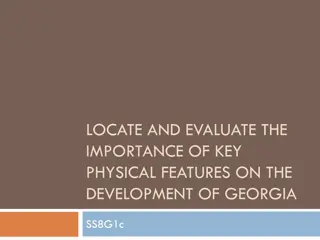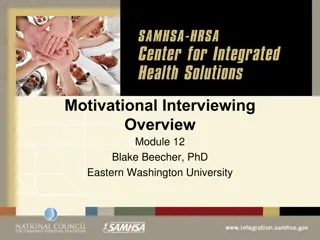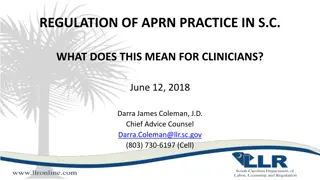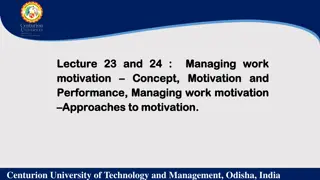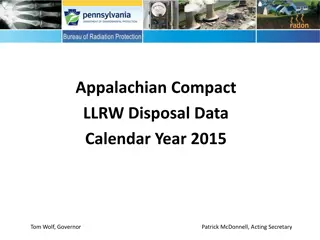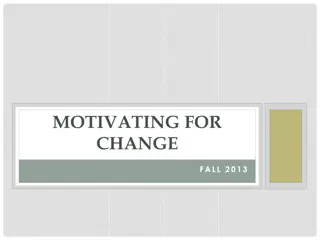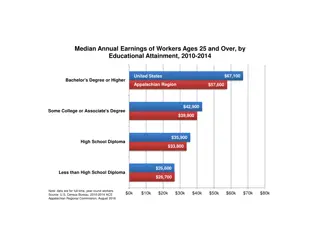Factors Influencing Independent Practice Motivation Among CRNAs in Appalachian Region
CRNAs play a vital role in providing anesthesia services independently in rural areas. This study explores the motivation factors driving CRNAs to practice autonomously, focusing on intrinsic and extrinsic motivators supported by Herzberg's theory of motivation.
Download Presentation

Please find below an Image/Link to download the presentation.
The content on the website is provided AS IS for your information and personal use only. It may not be sold, licensed, or shared on other websites without obtaining consent from the author.If you encounter any issues during the download, it is possible that the publisher has removed the file from their server.
You are allowed to download the files provided on this website for personal or commercial use, subject to the condition that they are used lawfully. All files are the property of their respective owners.
The content on the website is provided AS IS for your information and personal use only. It may not be sold, licensed, or shared on other websites without obtaining consent from the author.
E N D
Presentation Transcript
DMPNA OralDefense and Presentation FACTORS THAT MOTIVATE CERTIFIED REGISTERED NURSE ANESTHETISTS TO PRACTICE INDEPENDENTLY IN THE APPALACHIAN REGION Michael Lee Frame, Jr., CRNA, MS Friday, January 13, 2012
Study Supported By: Sara and Pauline Maier Foundation, Inc. CAMC Foundation, Inc. CAMC Institute
ResearchCommittee Dr. Dennis Emmett, DBA ~ Committee Chair Marshall University Lewis College of Business Dr. Cassy Taylor, CRNA, DNP, DMP, CNE CAMC School of Nurse Anesthesia Craig O Dell, CRNA, MS CAMC General Hospital and Thomas Memorial Hospital
Introduction Independent Certified Registered Nurse Anesthetists (CRNAs) provide anesthesia services without the supervision or medical direction of anesthesiologists in healthcare facilities throughout the United States. Approximately 27% of CRNAs working nationwide are practicing without anesthesiologists. The Appalachian region is a 205,000-square-mile area encompassing all of West Virginia and parts of 12 other states. The present literature is limited concerning the factors that motivate CRNAs to choose employment in rural independent practice.
LiteratureReview In some states CRNAs are the sole anesthesia providers in almost 100% of their rural facilities. The current shortage of nurse anesthetists practicing rurally in the U.S. will continue to worsen over time. CRNAs who are willing to work independently become increasingly more important in these rural locations. Advance practice registered nurses are capable of performing nursing interventions that influence patient outcomes, including direct patient care and various avenues of management and administration. To be motivated means that a person has been moved toward doing something.
Literature Review Continued Motivation can be divided into either intrinsic motivation or extrinsic motivation. Herzberg s theory of motivation was utilized as the theoretical framework for this study. The motivation factors, or intrinsic factors, are directly related to the satisfaction gained from a job. The hygiene factors, or extrinsic factors, are concerned with the job itself, but are not directly a part of it. Intrinsic factors that promote job satisfaction include achievement, recognition, responsibility, advancement, and the work itself. Extrinsic factors that prevent job dissatisfaction include salary, working conditions, company and administrative policies, supervision, and interpersonal relations.
Purpose The purpose of this prospective, quantitative survey was to identify and describe the factors that motivate CRNAs to practice independently in one of the 13 states of the Appalachian region. The objectives for this study were: 1) to describe the respondents, 2) to determine if there are any significant differences between the independent CRNAs from Appalachian and Non- Appalachian counties based on the factors of gender, marital status, highest degree earned, certification status, age, years of CRNA experience, and the ten motivation factors.
Methodology In a sample of CRNAs who practice independently in one of the 13 states of the Appalachian region there will be no differences between the CRNAs from Appalachian and Non- Appalachian counties in their responses to the motivation factors of achievement, recognition, responsibility, advancement, work itself, salary, working conditions, company and administrative policies, supervision, and interpersonal relations, regardless of gender, marital status, highest degree earned, certification status, age, and years of CRNA experience. The primary methodology for this prospective, quantitative research study was the utilization of a survey research design to collect data from CRNAs who practice independently in the Appalachian region.
Methodology Continued A sample of 5,000 CRNAs from the 13 states of the Appalachian region of the United States received an email survey distributed by the AANA. A sample of 5,000 CRNAs received an email survey, 155 recipients chose to opt-out of the survey. This resulted in 4,845 CRNAs that chose to accept the email invitation to participate in the survey. A total number of 460 CRNAs actually completed the survey, which resulted in a 9.5% response rate. After consideration of the inclusion criteria, 101 responding CRNAs were selected for the study (n = 101).
Methodology Continued The survey consisted of three sections: (a) demographic information (b) current anesthesia practice information (c) motivation factor statements The independent variables were the six demographic and anesthesia practice variables: gender, marital status, highest degree earned, certification status, age, and years of CRNA experience. The dependent variables were the ten motivation factors: achievement, recognition, responsibility, advancement, work itself, salary, working conditions, company and administrative policies, supervision, and interpersonal relations. Descriptive statistics were used to describe the respondents.
Results Two groups are represented in this sample of CRNAs (n = 101), the Appalachian respondents (n = 36) and the Non- Appalachian respondents (n = 65). No significant differences were demonstrated between the two groups of CRNAs based on gender, marital status, highest degree earned, or certification status. Demographic and anesthesia practice information for the Appalachian and Non-Appalachian respondents is found in Table 1.
Table 1: Demographic and Anesthesia Practice Information Survey Question Appalachian Non- (n = 101) Frequency Appalachian Significance (n = 36) Frequency (n = 65) Gender Male 21(58%) 34 (52%) .560 15 (42%) 31 (48%) Female Marital Status Single 4 (11%) 11(17%) .431 32 (89%) 54 (83%) Married Highest Degree Earned 16 (44%) 17 (26%) Bachelor s .061 20 (56%) 48 (74%) Master s or Doctorate Certification Status Certified 18 (50%) 37 (57%) .503 18 (50%) 28(43%) Recertified The accepted level of statistical significance for this study was p < .05.
Results Continued An independent samples t-test was conducted to examine whether there was a significant difference between the CRNAs from Appalachian and Non-Appalachian counties in relation to their age and years of CRNA experience. No significant differences were demonstrated between the two groups of CRNAs based on age or years of CRNA experience. These results can be found in Table 2.
Table 2: T-Test for Age and Years of CRNA Experience Survey Question Appalachian Non-Appalachian (n = 101) Mean Mean Significance (n = 36) (n = 65) Years of Age 52.33 50.75 .469 Years of CRNA 22.17 20.57 .502 Experience The accepted level of statistical significance for this study was p < .05.
Results Continued Each CRNA was asked to measure the degree of importance that they place on each motivation factor statement using a Likert scale (1-4) with 1 indicating strongly agree and 4 indicating strongly disagree. After calculating the means for each item, an independent samples t-test was conducted to compare these means. Statistically significant findings were noted for the question concerning the nature of the work itself (p = .050) and for the question concerning no anesthesiologist supervision (p = .030).
Results Continued The survey respondents were also asked if they had any further thoughts or ideas concerning what motivates CRNAs to practice independently. This one open-ended question resulted in a variety of comments from both the Appalachian and Non- Appalachian respondents. A summary of these comments can be found in Table 4.
Table 4: Open-Ended Question Comments What motivates CRNAs to practice independently? Appalachian Respondents Non-Appalachian Respondents Better income Desire to utilize training/education More salary Confidence in abilities/skills More respect Challenges of independent practice Location Greater autonomy Availability of jobs Control over scheduling Greater autonomy/responsibility Satisfaction of independent decision making Personal in nature Reward of successful anesthetic
Discussion The respondents were described (Objective 1) according to their demographic and anesthesia practice information, as well as, by their age and years of CRNA experience. The two groups were similar to each other concerning these variables. There were no significant differences between the independent CRNAs from Appalachian and Non-Appalachian counties based on gender, marital status, highest degree earned, certification status, age, and years of CRNA experience (Objective 2). As for the ten motivation factors (Objective 2), statistically significant findings were noted for the question relating to the nature of the work itself (p = .050) and for the question concerning no anesthesiologist supervision (p = .030).
Discussion Continued As for the statistically significant findings, the Non- Appalachian group more strongly agreed that the nature of the work itself motivates them to practice independently. Additionally, statistically significant findings were found after the analysis of the question concerning no anesthesiologist supervision. The Non-Appalachian group more strongly agrees that no anesthesiologist supervision motivates them to practice independently. They were of similar in age, 52.33 for the Appalachian group and 50.75 for the Non-Appalachian group, as well as similar in years of experience, 22.17 for the Appalachian group and 20.57 for the Non-Appalachian group.
Discussion Continued It may then be reasonable to assume that a difference should have also existed between the two groups concerning the level of responsibility. The survey used in this study containing primarily quantitative questions; however, the survey respondents were also asked if they had any further thoughts or ideas concerning what motivates CRNAs to practice independently. One Appalachian respondent explained that you really feel like you re doing something for the good of the people and many expressed that they are providing a need to their communities. An additional respondent shared that my community knows I am here and are comforted when they see me come in the door. That is quite a reward in and of itself .
Discussion Continued The Appalachian group seems to focus a portion of their motivation on the personal side independent practice. It seems that the Appalachian CRNAs are motivated by how others view their worth and contribution to their particular facility. It could be theorized that the Appalachian CRNAs practice in more remote areas and among smaller communities where a sense of closeness and family are commonplace. It appears that more control and the ability to practice to their fullest capability is more important to the Non-Appalachian CRNAs. It may be possible that many of these CRNAs have experience in larger institutions where they experience less control over their workday and a greater degree of supervision.
Study Limitations A significant limitation of this study was the unknown reliability and validity of the survey instrument. The size of the Appalachian group (n = 36) and the Non- Appalachian group (n = 65) were less than 68, which could have contributed to a type II error. In addition, this survey required CRNAs to choose their highest degree earned (excluded diploma or certificate CRNAs). This study focused on CRNAs practicing independently in the 13 states of the Appalachian region. The survey instrument was designed to survey the motivation of independently practicing CRNAs .
Implications and Recommendations Healthcare leaders in the 13 states of the Appalachian region can utilize the knowledge gained from this study to gain a better understanding of the factors that motivate CRNAs in their region to practice independently. Non-Appalachian healthcare leaders should be able to utilize this knowledge to begin strategically planning for future anesthesia needs in their facilities. It is possible that this email survey failed to capture what motivates CRNAs in the Appalachian group to practice independently. This study could be improved by selecting a specific AANA region to use as the target group or to conduct a nationwide survey. In addition, the survey instrument could be adapted to not only survey the motivation of independently practicing CRNAs, but also the motivation of all CRNAs in the target group.
Questions or Comments? Thank you for your time and attention!
FACTORS THAT MOTIVATE CERTIFIED REGISTERED NURSE ANESTHETISTS TO PRACTICE INDEPENDENTLY IN THE APPALACHIAN REGION
